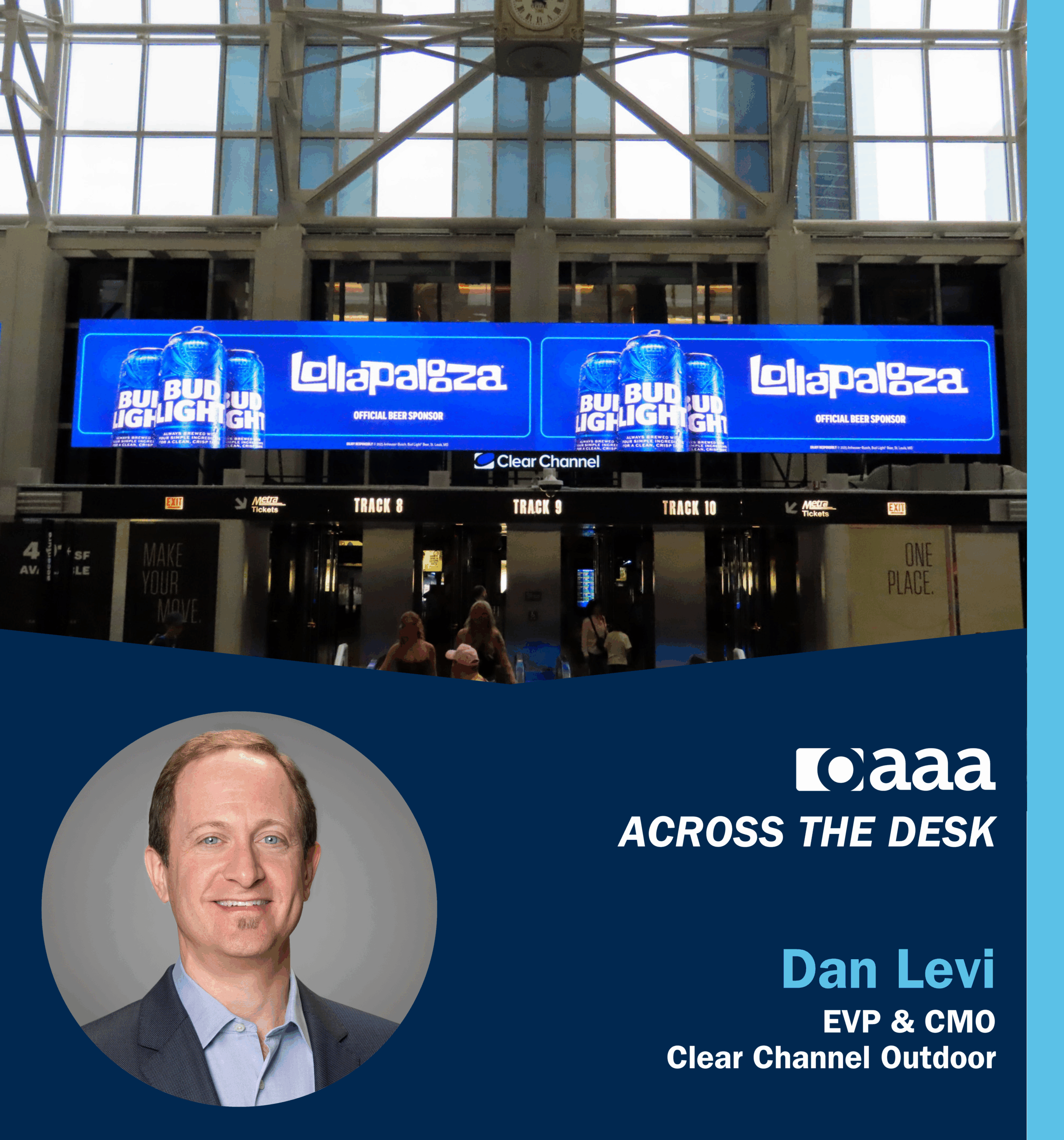
Every month, OAAA’s editorial team sits down with an industry leader to discuss the latest insights, trends, and best practices for the OOH industry. This month, we sat down with Clear Channel Outdoor’s EVP & CMO, Dan Levi who discussed what excites him about OOH right now, his message for brands that haven’t bought OOH before, and how advancements in data and measurement are helping OOH prove its effectiveness.
Read Dan’s Q&A in The Drum.
What excites you about OOH right now?
I think we’re at a moment in time where OOH can really shine, as the challenges of other media channels present opportunity for OOH.
Marketers have access to more data, dashboards and media channels than ever before, yet it’s increasingly challenging to reach a scaled audience with meaningful impact. Ad-free streaming, digital audience fragmentation, AI negatively impacting search performance, evolving privacy policies and regulations, and persistent challenges with digital ad fraud and brand safety continue to challenge marketers and agencies.
And through all this complexity and all these problems, there’s never been a stronger case for the role that OOH should play in the modern marketer’s media mix.
• We have a ton of research from OAAA, Kantar and others that speak to consumers’ preference for OOH as an advertising channel due to its nonintrusive nature, as well as consumers’ willingness to take action and respond to what they see on OOH inventory by visiting stores, searching for more information about the advertised brand, sharing on social, going to the advertiser’s website and more.
• The combination of digital OOH’s capabilities, along with some amazingly innovative creative work done by our industry to bring traditional printed inventory to life, allows advertisers to tell impactful, dynamic and very cool brand stories that break through the clutter and really resonate with consumers.
• As an industry, we’ve proven that the combo of OOH and mobile drive best performance for brands, which kind of makes sense when you consider that most exposures to OOH happen when people have a smartphone in their hand, pocket, bag or on the seat next to them.
• We have hundreds and hundreds of case studies that show how OOH drives measurable impact on a wide range of behaviors, including store visits, website activity, app downloads and usage, video viewing, social media impact and so much more.
But the thing that gets me most excited these days is that we’ve definitively proven not just that OOH works, but that it contributes incrementally to most advertisers’ media plans. As I discussed on a recent OAAA-hosted webinar, “The Proven Impact of OOH in Today’s Media Mix,” a 5- year longitudinal study by Kantar has shown that OOH drives better impact on key brand health metrics than connected TV or digital media. And on important metrics like ad awareness and purchase intent, OOH actually outperforms linear TV. And when you consider the billions and billions that are invested in digital, CTV & linear TV, the opportunity for OOH to earn our place on media plans has never been more direct or achievable.
What message do you have for brands that haven’t bought OOH before?
I talk about this frequently with customers and at conferences: I don’t believe there’s a consumer on the planet that thinks about media channels: they think about brands, experiences, personalities and ultimately how brands align with and add value to their lives. Yet we as a media industry obsess about media channels, and we continue to structure so much of how we work with marketers and agencies around this legacy framework.
So, my advice for brands and how they think about OOH: don’t think about media channels, think about audiences and outcomes. Yes, our medium is one where location is a huge part of the value proposition, but we’re not just about the locations or the structures; we’re about the audiences that can be reached in these locations by running ads on our structures. And we’re about the measurable and incremental performance that OOH has been proven to deliver to media plans.
I’ve had discussions with marketers or agency executives about OOH where they tell me that they “don’t have an OOH budget.” To which I love to say, “But do you have an audience budget?”
We now have the tools, data and proof of efficacy that should help OOH earn a place on more marketers’ plans if we simply help them pivot their thinking to see the incremental value of adding OOH to a plan and engaging with consumers as they go about their daily journeys in the physical world, armed with smartphones that allow them to not just be passively exposed to advertisers’ messages but to actively engage with and respond to their ads.
What’s the next big thing for OOH?
There’s been a ton of articles and industry discussions about the impact of AI on search marketing and how the shift from “search engines” to “answer engines” is making search less effective and more expensive for marketers. This presents a potentially huge opportunity for OOH. There’s been some great research from the OAAA that speaks to OOH’s ability to drive digital and mobile behaviors like searching for more information about brands advertising on OOH displays, all of which points to OOH as a potential solution to mitigate some of this degradation of search performance. But more so, it provides further reinforcement of why we as an industry should not just talk about inventory or structures and instead embrace a focus on audiences and outcomes. We need to talk with customers about these issues, understand how they’re experiencing and managing through these changes in business performance and results, and use this as an opportunity to talk about the measurable impact that OOH has in engaging consumers and driving them to take action.
How is OOH’s advancement in data and measurement enabling the medium to prove effectiveness and earn a bigger place in brand strategies?
It wasn’t that long ago where the primary question about OOH was whether it was a measurable medium. I think our industry has done a fantastic job definitively proving that yes, OOH is measurable and has been consistently shown to deliver impact on marketers’ business performance. The challenge to our industry now is whether we can provide that measurement in the ways that marketers and agencies expect, which is not via post-campaign reporting but as a feed of data that allows them to understand performance while the campaign is running, so they can optimize similar to how they handle digital media.
In other words, can we build on the scale, impact, reach and creative storytelling that are the strengths of our medium, to actually operate as a digital medium? And to be clear, by “digital medium” I don’t mean the form of the displays; I mean how we think, act and provide insights to marketers.
The good news: through some innovations that Clear Channel and others have brought to market, we’re already on our way to acting like a digital medium at scale.
Three very specific, very real examples of how we’re doing this today:
• Clear Channel recently launched a new product called Inflight Insights, which provides marketers with insights into campaign performance while the campaign is still running. Marketers can receive a weekly report on how people exposed to their OOH campaign are performing. Initially focused on the KPI of visits to stores and other physical locations, Inflight Insights helps marketers understand things like when people visit the advertised stores, how far they travel to visit, where the last OOH exposure was before visiting, other interests & behaviors of those that visit and so much more. Inflight Insights was also built to provide the same insights for other KPIs that Clear Channel will be adding in the near future, including understanding OOH’s impact on website visits and conversions and how people respond to surveys about brand health metrics.
• Clear Channel and others have done integrations with LiveRamp and other data on-boarders and Data Clean Rooms, allowing marketers to activate their 1st and 3rd party audience segments across OOH, just as they do with digital media. To be clear, this is not just a programmatic functionality; at Clear Channel, this ability to on-board and activate audiences applies to all Clear Channel media formats – traditional printed displays as well as digital displays – regardless of whether they are transacted programmatically or via direct deals between buyers and CCO.
• These same integrations allow marketers to ingest OOH performance data into their multi-touch attribution models and marketing mix models, helping them to understand and persistently measure the incremental impact of adding OOH to a mix. Clear Channel has multiple customers and partners for whom we don’t provide attribution measurement; we provide data. By providing this type of data integration, we are truly acting like a digital medium, in ways that meet the needs and expectations of digital marketers and digital agency buyers.
If we as an industry want to truly earn a bigger place in brand strategies and on digital and audience-led media plans, these are just some of the ways that we need to embrace how digital media works, how it’s measured and optimized, and step up to operate not how we’ve always done, but how digital marketers expect us to operate today.
Published: October 17, 2025
